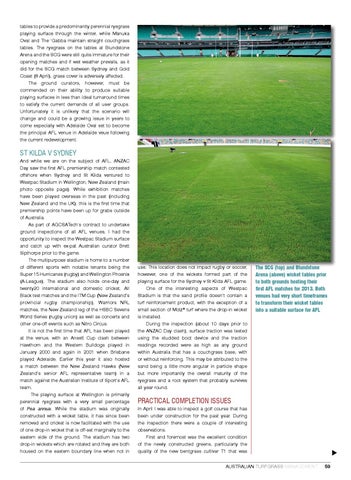tables to provide a predominantly perennial ryegrass playing surface through the winter, while Manuka Oval and The ‘Gabba maintain straight couchgrass tables. The ryegrass on the tables at Blundstone Arena and the SCG were still quite immature for their opening matches and if wet weather prevails, as it did for the SCG match between Sydney and Gold Coast (8 April), grass cover is adversely affected. The ground curators, however, must be commended on their ability to produce suitable playing surfaces in less than ideal turnaround times to satisfy the current demands of all user groups. Unfortunately it is unlikely that the scenario will change and could be a growing issue in years to come especially with Adelaide Oval set to become the principal AFL venue in Adelaide veue following the current redevelopment.
A
B
St Kilda v Sydney
use. This location does not impact rugby or soccer, however, one of the wickets formed part of the playing surface for the Sydney v St Kilda AFL game. One of the interesting aspects of Westpac Stadium is that the sand profile doesn’t contain a turf reinforcement product, with the exception of a small section of Motz® turf where the drop-in wicket is installed. During the inspection (about 10 days prior to the ANZAC Day clash), surface traction was tested using the studded boot device and the traction readings recorded were as high as any ground within Australia that has a couchgrass base, with or without reinforcing. This may be attributed to the sand being a little more angular in particle shape but more importantly the overall maturity of the ryegrass and a root system that probably survives all year round.
The SCG (top) and Blundstone Arena (above) wicket tables prior to both grounds hosting their first AFL matches for 2013. Both venues had very short timeframes to transform their wicket tables into a suitable surface for AFL
Practical completion issues In April I was able to inspect a golf course that has been under construction for the past year. During the inspection there were a couple of interesting observations. First and foremost was the excellent condition of the newly constructed greens, particularly the quality of the new bentgrass cultivar T1 that was Australian Turfgrass Management
s
And while we are on the subject of AFL, ANZAC Day saw the first AFL premiership match contested offshore when Sydney and St Kilda ventured to Westpac Stadium in Wellington, New Zealand (main photo opposite page). While exhibition matches have been played overseas in the past (including New Zealand and the UK), this is the first time that premiership points have been up for grabs outside of Australia. As part of AGCSATech’s contract to undertake ground inspections of all AFL venues, I had the opportunity to inspect the Westpac Stadium surface and catch up with ex-pat Australian curator Brett Sipthorpe prior to the game. The multipurpose stadium is home to a number of different sports with notable tenants being the Super 15 Hurricanes (rugby) and Wellington Phoenix (A-League). The stadium also holds one-day and twenty20 international and domestic cricket, All Black test matches and the ITM Cup (New Zealand’s provincial rugby championship), Warriors NRL matches, the New Zealand leg of the HSBC Sevens World Series (rugby union) as well as concerts and other one-off events such as Nitro Circus. It is not the first time that AFL has been played at the venue, with an Ansett Cup clash between Hawthorn and the Western Bulldogs played in January 2000 and again in 2001 when Brisbane played Adelaide. Earlier this year it also hosted a match between the New Zealand Hawks (New Zealand’s senior AFL representative team) in a match against the Australian Institute of Sport’s AFL team. The playing surface at Wellington is primarily perennial ryegrass with a very small percentage of Poa annua. While the stadium was originally constructed with a wicket table, it has since been removed and cricket is now facilitated with the use of one drop-in wicket that is off-set marginally to the eastern side of the ground. The stadium has two drop-in wickets which are rotated and they are both housed on the eastern boundary line when not in
59
